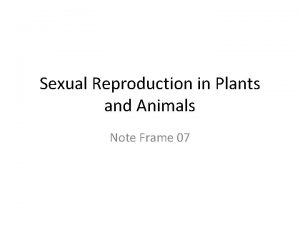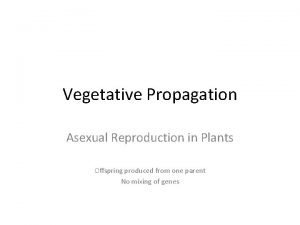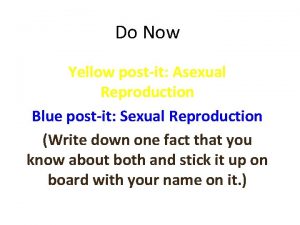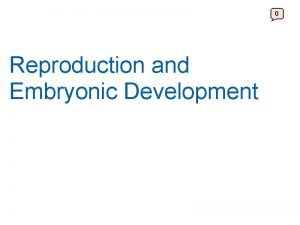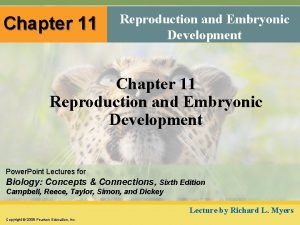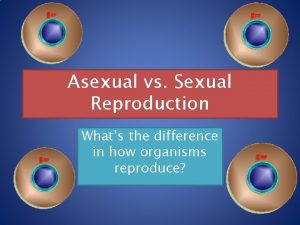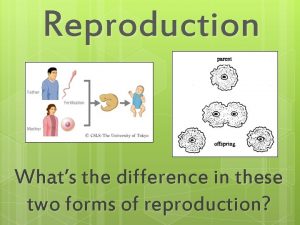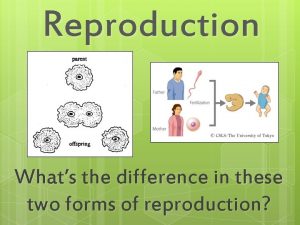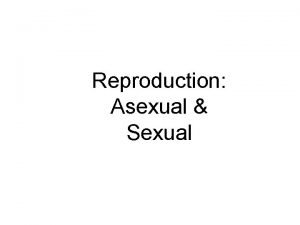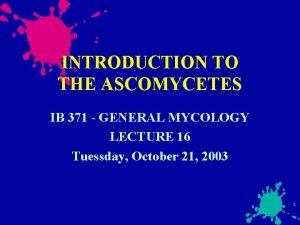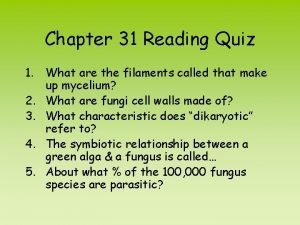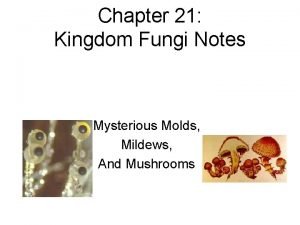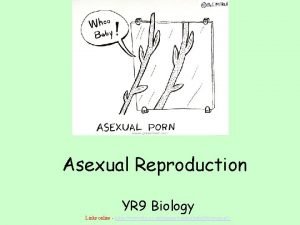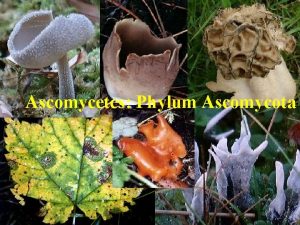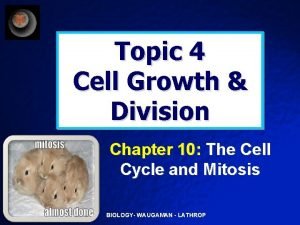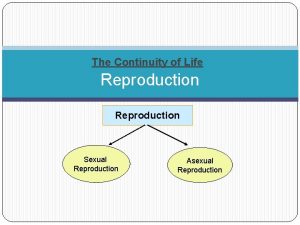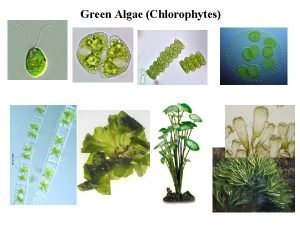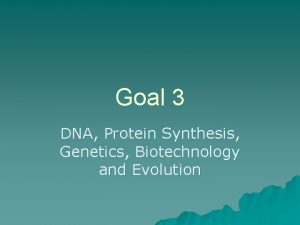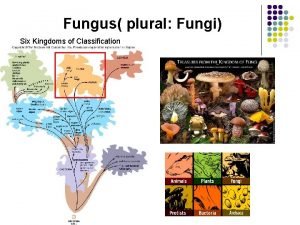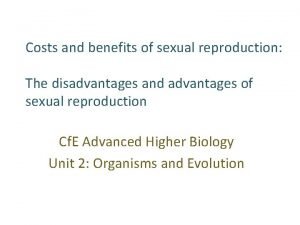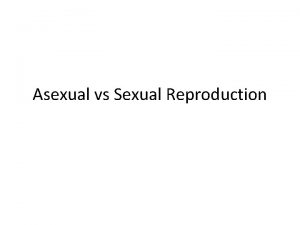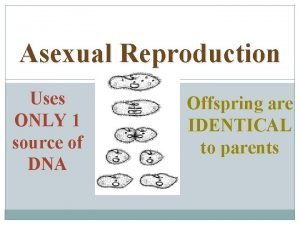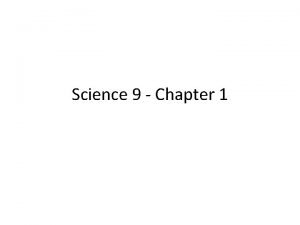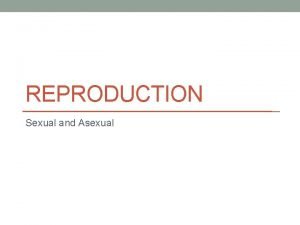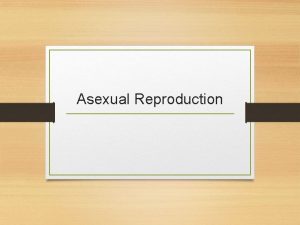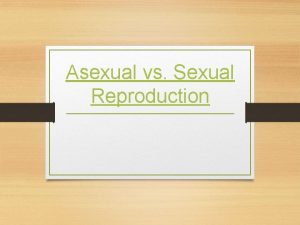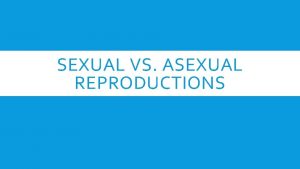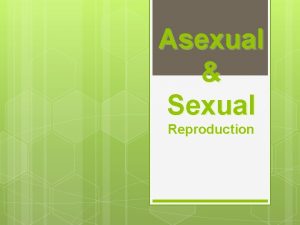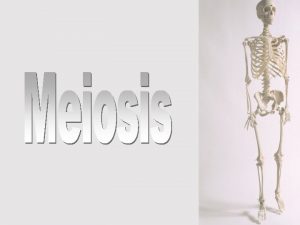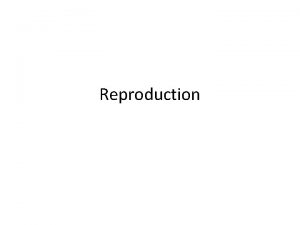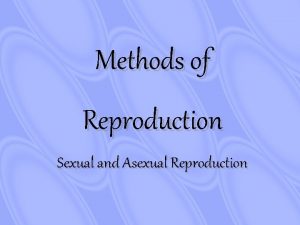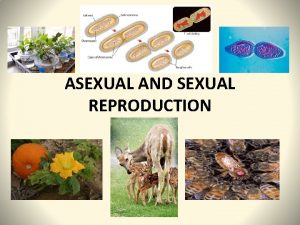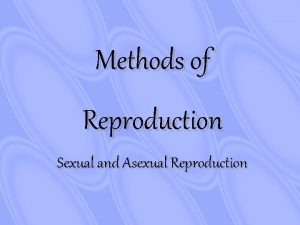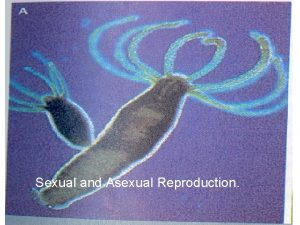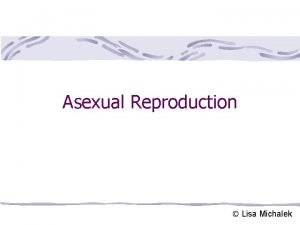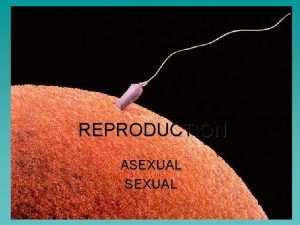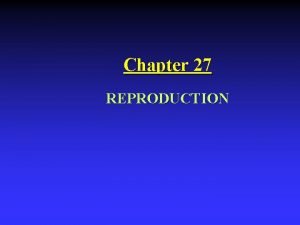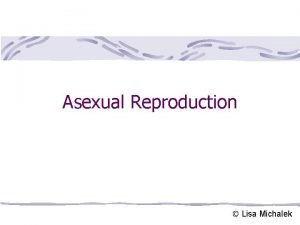Meiosis Asexual reproduction and Meiosis Advantages of Asexual









































- Slides: 41

Meiosis Asexual reproduction and Meiosis

Advantages of Asexual Reproduction • Eliminates the need to find a mate • May reproduce at a faster rate • May produce larger number of offspring using less overall energy and resources • Optimum in stable unchanging environments • Uses mitosis 2

Types of Asexual Reproduction Budding - an offspring simply grows out of the body of the parent as exhibited by this hydra. 3

Types of Asexual Reproduction Gemmules - The parent releases a specialized mass of cells that can develop into an offspring. Gemmules are overwintering balls that are produced in the late summer/early fall by the adult sponge. 4

Types of Asexual Reproduction Fragmentation - occurs when the body of the parent breaks into distinct pieces, each of which can produce an offspring. Planarian are famous for this! 5

Types of Asexual Reproduction n. Regeneration- A piece of an organism is detached and develops into a completely new individual. 6

Types of Asexual Reproduction n. Parthenogenesis – is a form of asexual reproduction in which growth and development of embryos occur without fertilization. In animals, parthenogenesis means development of an embryo from an unfertilized egg cell! 7

Advantages of Sexual Reproduction • Varied number phenotypic offspring. • Better response to varying environment. Sexual reproduction involves the union of two haploid cells from different parents to produce a diploid zygote. Meiosis is a special type of cell reproduction found in organisms that reproduce sexually. 8

Diploid Life Cycle • The advantage of being diploid is that deleterious genes can be masked if they are recessive. • The disadvantage is that with more chromosomes to manage, there is an increased likelihood that something will go awry! 9

A Diploid Cell 10

Human Somatic Chromosomes • Humans have 23 pairs of chromosomes in their somatic cells. • These chromosomes have been stained and certain banding patterns appear. • The two chromosomes in each pair are called homologous chromosomes, or homologs. • Chromosomes in a homologous pair are the same length and carry genes controlling the same inherited characters. 11

Human Karyotype • A karyotype is an ordered display of the pairs of chromosomes from a given cell arranged from longest to shortest. • Autosomes are non-sex chromosomes. • Notice that the sex chromosomes in this karyotype are not homologous. What does that signify? 12

Meiosis Overview (Caution! More Details Coming…) • This is a special type of cell division where ONE diploid cell produces FOUR haploid cells that are genetically different from one another. • There are TWO cell division events, and they are called meiosis I and II. • Meiosis I produces 2 haploid cells with double stranded chromosomes (chromosomes have 2 chromatids). The cells are genetically different. • Meiosis II produces 4 haploid cells that separate the sister chromatids. 13

Meiosis I: Cut Chromosome Number in Half This cell division results in two genetically different haploid cells that contain double stranded chromosomes. 1 cell (4 double-stranded chromosomes) 2 cells (2 double-stranded chromosomes) 14

Meiosis II: Produce 4 Haploid Gametes Results in four haploid cells by separating the 2 cells with double-stranded chromosomes into 4 cells with 2 singlestranded chromosomes. 2 cells (2 double-stranded, haploid chromosomes) 4 cells (2 single-stranded, haploid chromosomes) 15

Interphase • G 1, S, G 2 of the cell cycle ( DNA is replicated in S) • Centrosomes with a pair of centrioles (not in higher plant cells) replicate. • Centrosomes are microtubules organizing centers 16

Prophase/Prometaphase I Prophase I • Chromosomes are visible as long separated filaments • Homologous chromosomes pair and align as long well-separated filaments. • Recombination nodules attach and crossing over occurs. . 17

Synapsing • Homologous pairs form a protein structure between them called the synaptonemal complex. This keeps the homologs as a tetrad. • Places where crossing over occurs is called a chiasma. • In mitosis, kinetochore microtubules attach to both sides of the centromere, but in meiosis I they on attach to one side. 18

Forming the Tetrad • When synapsing occurs, the chromosomes do not lie side by side but rather on top of each other with a protein called the synaptonemal complex holding them together. 19

Effects of Crossing Over on Genetic Variation • Compare the results of the chromosomes in which no crossing occurs over versus the result of crossing over. 20

Attaching Kinetochore Microtubules During Meiosis I, kinetochore microtubules attach to only to one side. 21

Metaphase I The homologous chromosomes move as unit to the metaphase plate. Each homolog has different kinetochore microtubules attached to the centromeres from opposite poles. Which side of the metaphase plate the chromosomes line up on is a matter of chance. 22

Arrangement of Chromosomes on the Metaphase Plate Results in Genetic Variation How chromosomes line up on the metaphase plate, affects the genetic composition of the cell.

The Effect of Adding an Additional Chromosome Pair on the Metaphase Plate If we increase the number of chromosomes from two to three, how many different gametes can be formed? 24

Anaphase I • Centromeres do not separate. • Homologous chromosomes do separate and move apart to opposite poles. • Spindle fibers from opposite poles interact to force poles apart. 25

Nondisjunction n Nondisjunction occurs when problems with the meiotic spindle cause errors in daughter cells. n This may occur if tetrad chromosomes do not separate properly during meiosis I. n Alternatively, sister chromatids may fail to separate during meiosis II. 26

Aneuploidy n If the gamete is fertilized, the resulting cells will not have the proper number of chromosomes and is called aneuploidy. 27

Telophase I I • The chromosomes are still double stranded containing two hybrid chromatids. • The double-stranded chromosomes have migrated to the poles. • The number of chromosomes is the haploid number of chromosomes. 28

Meiosis II Interkinesis- This is the time between meiosis I and meiosis II. No DNA replication occurs during this time. It is like mitosis but the DNA has already been replicated. It separates double stranded chromosomes. into single stranded chromosomes. 29

Interkinesis • This is the time between meiosis I and meiosis II. • Haploid daughter cells; no further DNA replication occurs during this time. 30

Prophase/Prometaphase II • Centrosomes replicate and begin to move apart. • Chromosomes appear as long thin threads Nucleolus becomes less distinct. (Middle) • Asters begin to form. Twin chromatids become visible. • Kinetochore microtubules attach to the kinetochores. Spindle forms. Membrane begins to disappear. 31

Pro-metaphase I vs. Pro-metaphase II 32

Metaphase II • Membrane has disappeared. • Double stranded chromosomes have moved single file to the metaphase plate. Microtubules attach to both sides of the kinetochore. • The spindle fibers over lap one another. They will interact with one another to push the poles apart. 33

Anaphase II • Centromeres have separated and move the sister chromosomes toward opposite poles. • Overlapping spindle microtubules from opposite poles interact and to pull the poles apart. 34

Telophase II • Nuclear membrane begins to form. Chromosomes begin to uncoil, become thinner. • Cytokinesis begins. 35

Gametogenesis in Humans • Spermatogenesis: The four equal sized cells produced in meiosis will differentiate and become sperm cells. • Oogenesis: During cytokinesis, there is unequal division of the cytoplasm with usually one large cell and three smaller cells. 36

Oogenesis Human ovum with three polar bodies. 37

Mitosis Versus Meiosis 38

Mitosis Versus Meiosis 39

Sexual Reproduction Provides Genetic Variability to Population • Crossing over • Random arrangement of chromosome when lining up on the metaphase plate • Random fertilization of gametes • Choice of mates 40

What’s the Scoop? 41
 Hare lynx
Hare lynx Binary fission in bacteria
Binary fission in bacteria Venn diagram of asexual and sexual
Venn diagram of asexual and sexual Example of asexual
Example of asexual Difference of sexual and asexual reproduction
Difference of sexual and asexual reproduction Venn diagram of meiosis and mitosis
Venn diagram of meiosis and mitosis Venn diagram asexual and sexual reproduction
Venn diagram asexual and sexual reproduction Sexual and asexual reproduction
Sexual and asexual reproduction Animal sexual reproduction
Animal sexual reproduction Where does cactus store water
Where does cactus store water Parthenogenesis
Parthenogenesis Dahlia asexual reproduction
Dahlia asexual reproduction Examples of asexual reproduction
Examples of asexual reproduction Asexual reproduction flatworms
Asexual reproduction flatworms Layering asexual reproduction
Layering asexual reproduction Asexual
Asexual Asexual reproduction
Asexual reproduction Asexual reproduction
Asexual reproduction Whats asexual reproduction
Whats asexual reproduction Chapter 19 asexual reproduction
Chapter 19 asexual reproduction Whats asexual reproduction
Whats asexual reproduction Whats asexual reproduction
Whats asexual reproduction Advantages of genetic diversity
Advantages of genetic diversity Mitospore
Mitospore Chytridiomycota
Chytridiomycota Multicellular fungi are composed of thin filaments called
Multicellular fungi are composed of thin filaments called Budding asexual reproduction
Budding asexual reproduction Runner plant examples
Runner plant examples Ascomycete
Ascomycete How do angiosperms reproduce
How do angiosperms reproduce Asexual reproduction of budding
Asexual reproduction of budding Sexual or asexual reproduction
Sexual or asexual reproduction Phylum echinodermata
Phylum echinodermata Asexual reproduction in green algae
Asexual reproduction in green algae Asexual reproduction of budding
Asexual reproduction of budding Plural form of fungus
Plural form of fungus Parthenogenesis asexual reproduction
Parthenogenesis asexual reproduction Sexual or asexual reproduction
Sexual or asexual reproduction Asexual reproduction
Asexual reproduction Asexual reproduction involves *
Asexual reproduction involves * Mitosis and meiosis venn diagram
Mitosis and meiosis venn diagram Reproduction
Reproduction









